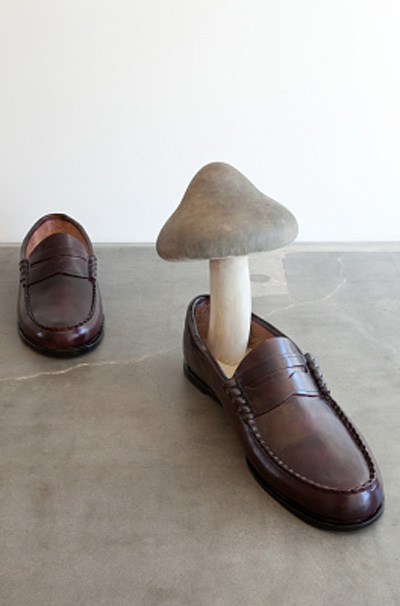
Continuing through October 27, 2012
Friedrich Kunath’s latest show has a bit of the spectacle about it, though it does offer more than just that. The custom-carpeted floors – yellow for the main room, orange and red for the smaller adjacent spaces – are filled with paintings and sculptures, the latter primarily oversized pairs of loafers, which march through the gallery filled with, among other items, tchotchke-like fruits, a mushroom, and a small palm tree. There are also a few larger sculptures, an installation, a painted metal vacation sign announcing Café Pathetique, and a 40-inch diameter button pin that reads “I (heart) Melancholy,” which is in fact titled “Actually, I Don’t.” I want to say that one of the loafers doubled as a sand-filled ashtray, which, in concert with the quasi-carnival atmosphere, puts one in mind of Damien Hirst (Gagosian-esque gallery guards even appear on the scene).
The marching loafers, a recurring footprints-in-the-sand motif of Kunath’s, is dubbed "Honey, I'm Home," which is in keeping with his oeuvre of sad-sack working drone existentialism. Kunath's local solo presentations, including his 2010 effort in the Hammer lobby, have always been installation oriented, but his paintings tend to be the central destination. He employs a few interplaying styles, primarily vintage joke cartoons and clip-art-like illustrations and text in combination with stained, brightly colored backgrounds and painted figures across the foreground. There's also the introduction of a group of more drawing-like paintings, on backgrounds of faux blue-lined paper. Most paintings are laced with an aura of humor, even comedy, mixed with melancholy, as reflected in titles such as "Year of Magical Drinking (Heartbreak Version)," "Not Every Clown Belongs in the Circus," and "Baby It's Cold Inside."
A key pervasive element of the show is the soundtrack coming from the designated screening room, which is substantial in coloring one's experience and anchors the rest of the work. It's an ambitious, nearly 17-minute video called "You Go Your Way and I'll Go Crazy," and features a single character, who is both the protagonist and a stand-in for the artist, albeit one who appears to be about 30 years Kunath's senior. This Beckett-looking avatar is seen engaging in various activities, from leisure (sailing in the ocean, swimming in a pool, hitting tennis balls from a machine) to studio work, including producing his paintings and sanding down his loafers. At intervals throughout, the sole character has his hands on a land-line phone, waiting for calls that won't come and making calls that don't seem to go through (at one point as he's walking along the beach with the phone, and we see the cord dangling impotently along the shore). There are also playfully angst-ridden moments, such as when our hero lovingly caresses Kunath's banana sculpture, or when he gets deeply pensive looking out into the canyons of Malibu.
A crucial accompaniment to these visuals is the perfectly customized professional score, which with bracing violins hits just the right accents of intermittent distress and despair, but without being overbearing. The video may be a Rorschach test for one's own life perspective, whether half-full, half-empty, or something more complex, but it becomes apparent in retrospect that the video, while often amusing, is rarely funny. While "You Go Your Way" clearly sets the tone for the rest of the show, it may be to easy to claim that it casts a tent over all of Kunath's work. On one hand, the work inevitably alludes to clichés around angst-ridden artists, mixed with notions of the dandy, the fop, and perhaps even the patron. On the other, Kunath draws attention, perhaps inadvertently, to his own life and production as a successful artist. Given the opportunity, I would be compelled to ask Kunath how he reconciles tragicomic themes of the bungling schlemiel with his own actual status. Even as that question arises, there is, beneath the surface of the work, a pervasive self-effacingness that suggests a state of mind, or at least inquiry, that perhaps never goes away, regardless of his success. There's far too much romanticism in Kunath's long-term investigation to simply see it as philosophical inquiry in the absence of a personal stake. As challenging as it may be to uncover Kunath's empathy with the everyman working-schlub, it must be so, because such an ongoing commitment otherwise would be tragic, and not particularly tragicomic.
Published courtesy of ArtSceneCal ©2012
